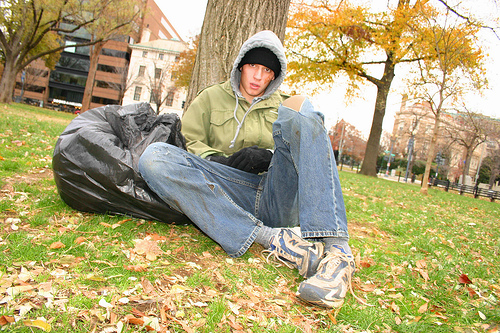
Sixteen months after a coalition of San Diego nonprofit groups took the county’s most costly homeless people – highest consumers of ambulance rides, emergency room and police resources – and put them into permanent housing, the cost savings are adding up.
Early calculations suggest that costs are down by nearly $1 million.
But it’s more than money saved.
“Project 25 saved my life,” says Paige, 46. “I’d be dead if they hadn’t got me off the streets.”
Perhaps, but Paige has demonstrated remarkable resilience while living on the street. The Georgia native has had a number of surgeries – both knees, one shoulder and several head injuries – from injuries and violence while she lived on the streets of San Diego.
But her life has definitely gotten better.
“I’ve been stabbed. I’ve been beaten,” she said. “So I have to be in control all the time. They can let me do that and that will keep me here.”
Paige reflects the realities of Project 25 client – there are now 36 (30 men and six women), instead of the original 25.
“A lot of these people are severely damaged, and they may not have a full recovery,” says Kris Kuntz, program analyst for Project 25 at the St. Vincent de Paul Villages. “They still have problems but the quality of problems has changed – we can get them to see doctors, to start therapy, to control their substance abuse and that takes them out of emergency services.”
United Way is the lead funder on the effort, a three-year project which is aimed at reducing the burden on emergency services, and stabilizing the lives of the 36 people involved so they can get the medical and psychological treatment that will help them remain stable.
The 35 people who have moved into leased apartments – through the San Diego Housing Commission and with MHSA vouchers – are people who’ve failed conventional treatment. Ninety percent are alcoholics with a second disorder, including mental health challenges, and 80 percent have complex medical issues.
“The standard treatment models have failed for our people and even with the bar set low for our shelter, these people couldn’t fit,” said Marc Stevenson program director of Project 25. “We didn’t know this population – they don’t come to seek housing or they don’t stay.”
“They’ve settled into accessing service with the lowest requirements – the jails and hospitals,” he added. “They’re the only places willing to work with them when they’re a mess.”
The project was designed so the social workers and staff who deal with them can learn as they go. Although St. Vincent de Paul is already steeped in the culture of poverty, this special group had its own norms and systems that the counselors had to learn.
For example, Stevenson said, a bus pass is everything to the hardcore homeless. “There’s an elaborate system for sharing the bus passes amongst themselves,” he said. “We had to make room for their relationships and their needs, which aren’t what healthy people expect.”
Many of the 36 miss the people they lived with on the street, and the program lets them go out for a few days and hang out with their old partners. It also allows them to have someone – a partner – come and stay with them.
“Finding landlords and making sure they know they will have our very strong and proactive support was one of the biggest challenges,” Kuntz said. “We make sure that someone is always available to take calls – 24 hours a day – from the clients and the landlords to deal with problems that come up.”
The managers identified the clients by visiting hospital emergency rooms, getting jail data and crunching it, then approaching the clients individually to try to talk them into participating.
“I thought they were nuts, offering me a free apartment,” Paige said. “I told him to get away from me but he kept coming up and talking to me about it.”
She now lives in a one bedroom apartment with her cat and she takes her medication on time because she knows where it is. The counselors keep track of it and keep it refilled. She’s on her way to an orthopedic surgeon for help with pain in one of her knees.
“It’s the first time I could get help before everything went wrong since I ran away from home when I was 16,” she said.
The figures on cost savings are preliminary, but impressive.
In the first year, one client went from $131,000 in emergency medical care to a total cost – including housing – of $41,000, according to initial figures. Another, who consumed $171,000 in emergency care in 2010, had just $830 in ER costs in 2011 – and a total cost of $27,000 for his housing and treatment.
That client, Albin, usually slept on park benches.
“I used to go to the hospital when I was freezing, tell them I had a backache,” he said. “I still feel like my real doctor was at the ER because they know my name when I go there. You watch CNN on the waiting room TV and you keep warm.”
Albin likes living indoors and he has started reducing his alcohol use – though he still consumes enough to kill a normal person.
“They look after us and they’re always asking how we feel and there are any problems we can help with,” Albin said. “I hope I can stay here forever.”





